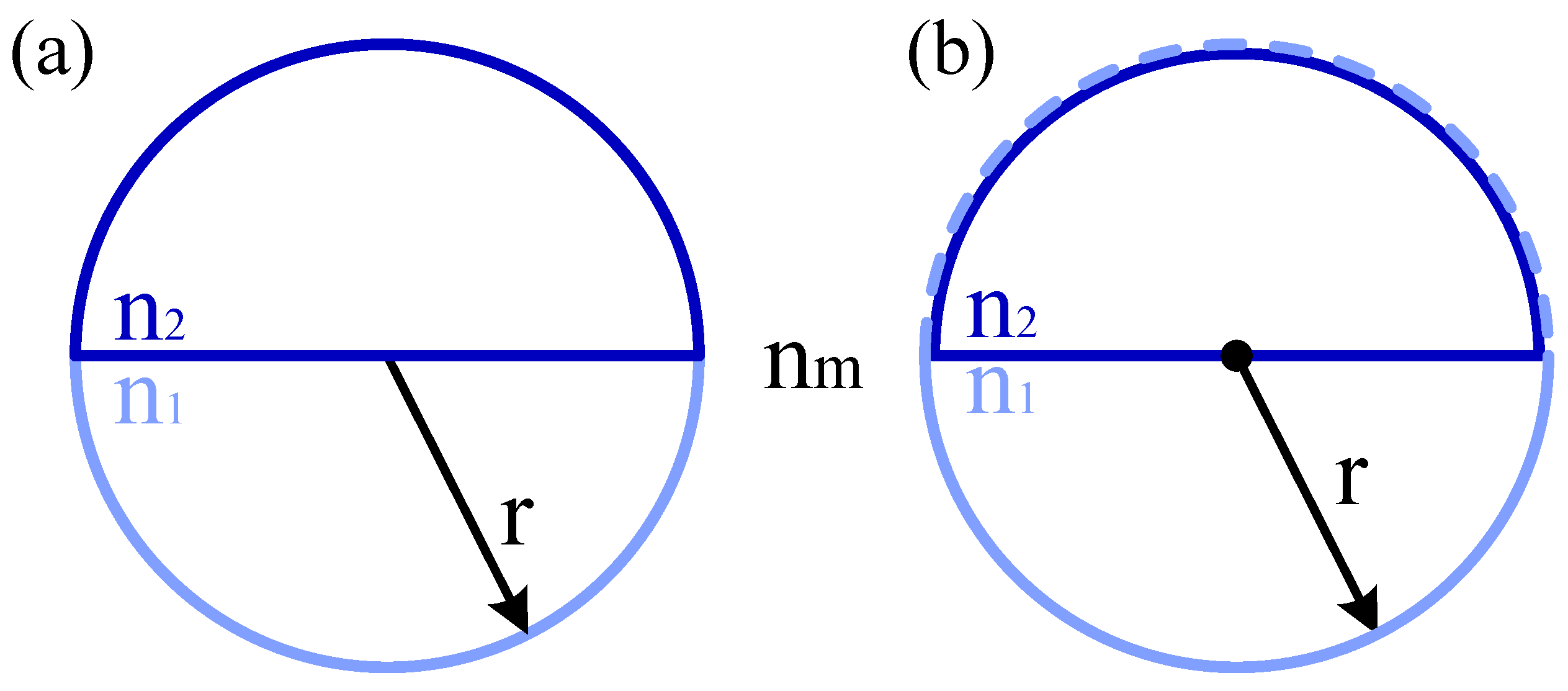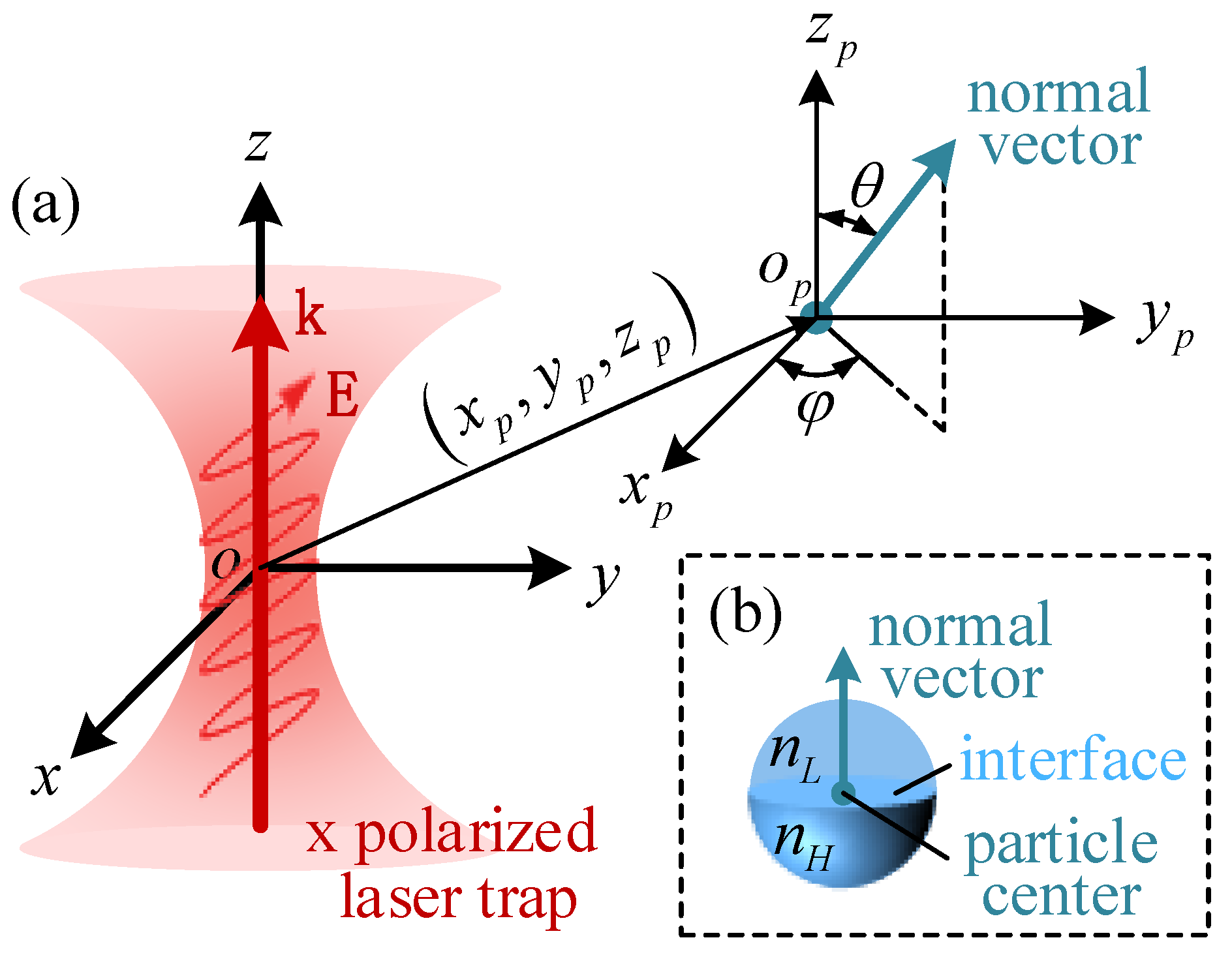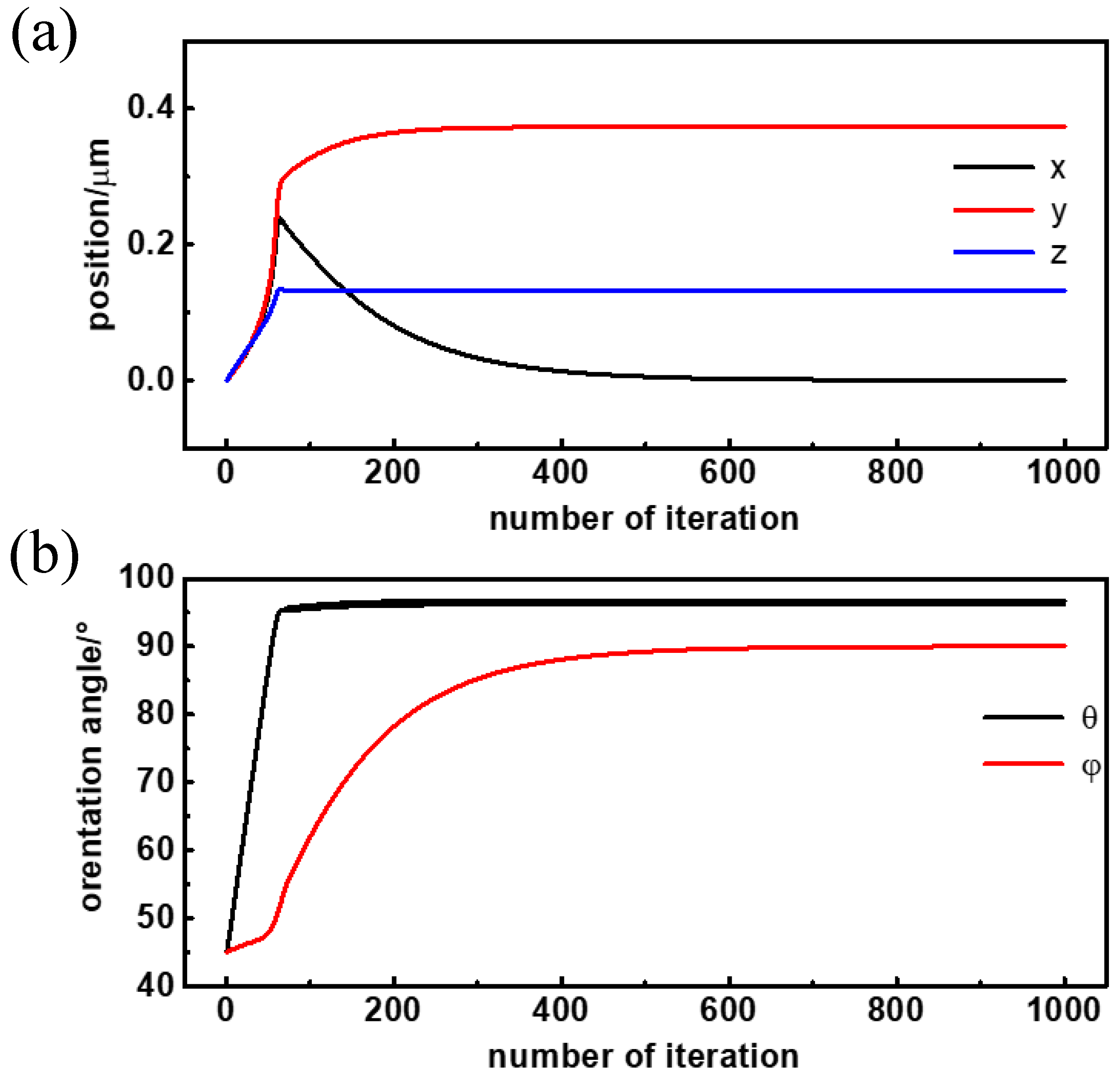Simulation and Experiment of the Trapping Trajectory for Janus Particles in Linearly Polarized Optical Traps
Abstract
:1. Introduction
2. Basic Theory of T-Matrix
3. Calculating Transition Matrix T
3.1. Transition Matrix of Homogeneous Particles
3.2. Transition Matrix of Janus Particles
4. Simulation Results
4.1. Coordinate Description of the Janus Particle
4.2. Trapping Trajectory and Steady Position and Orentation of Janus Particles
4.3. Trapping Process of Janus Particle with a Curved Interface
5. Experiment Results
6. Discussion
Author Contributions
Funding
Institutional Review Board Statement
Informed Consent Statement
Data Availability Statement
Conflicts of Interest
References
- Ashkin, A.; Dziedzic, J.M.; Bjorkholm, J.E.; Chu, S. Observation of a single-beam gradient force optical trap for dielectric particles. Opt. Lett. 1986, 11, 288–290. [Google Scholar] [CrossRef] [PubMed] [Green Version]
- Gieseler, J.; Gomez-Solano, J.R.; Magazzù, A.; Castillo, I.P.; García, L.P.; Gironella-Torrent, M.; Viader-Godoy, X.; Ritort, F.; Pesce, G.; Arzola, A.V.; et al. Optical tweezers—from calibration to applications: A tutorial. Adv. Opt. Photonics 2021, 13, 74–241. [Google Scholar] [CrossRef]
- Xin, H.; Zhao, N.; Wang, Y.; Zhao, X.; Pan, T.; Shi, Y.; Li, B. Optically controlled living micromotors for the manipulation and disruption of biological targets. Nano Lett. 2020, 20, 7177–7185. [Google Scholar] [CrossRef] [PubMed]
- Zou, X.; Zheng, Q.; Wu, D.; Lei, H. Controllable cellular micromotors based on optical tweezers. Adv. Funct. Mater. 2020, 30, 2002081. [Google Scholar] [CrossRef]
- Pesce, G.; Jones, P.H.; Maragò, O.M.; Volpe, G. Optical tweezers: Theory and practice. Eur. Phys. J. Plus 2020, 135, 949. [Google Scholar] [CrossRef]
- Landenberger, B.; Rohrbach, A.Y. Towards non-blind optical tweezing by finding 3d refractive index changes through off-focus interferometric tracking. Nat. Commun. 2021, 12, 6922. [Google Scholar] [CrossRef]
- Lee, M.; Kim, K.; Oh, J.; Park, Y. Isotropically resolved label-free tomographic imaging based on tomographic moulds for optical trapping. Light Sci. Appl. 2021, 10, 102. [Google Scholar] [CrossRef]
- Li, T.; Xu, X.; Fu, B.; Wang, S.; Li, B.; Wang, Z.; Zhu, S. Integrating the optical tweezers and spanner onto an individual single-layer metasurface. Photonics Res. 2021, 9, 1062–1068. [Google Scholar] [CrossRef]
- Otte, E.; Denz, C. Optical trapping gets structure: Structured light for advanced optical manipulation. Appl. Phys. Rev. 2020, 7, 041308. [Google Scholar] [CrossRef]
- Shan, Z.; Zhang, E.; Pi, D.; Gu, H.; Cao, W.; Lin, F.; Cai, Z.; Wu, X. Controlled rotation of cells using a single-beam anisotropic optical trap. Opt. Commun. 2020, 475, 126169. [Google Scholar] [CrossRef]
- Tang, X.; Nan, F.; Yan, Z. Rapidly and accurately shaping the intensity and phase of light for optical nano-manipulation. Nanoscale Adv. 2020, 2, 2540–2547. [Google Scholar] [CrossRef]
- Wen, J.; Gao, B.; Zhu, G.; Liu, D.; Wang, L.-G. Precise position and angular control of optical trapping and manipulation via a single vortex-pair beam. Opt. Lasers Eng. 2022, 148, 106773. [Google Scholar] [CrossRef]
- La Porta, A.; Wang, M.D. Optical torque wrench: Angular trapping, rotation, and torque detection of quartz microparticles. Phys. Rev. Lett. 2004, 92, 190801. [Google Scholar] [CrossRef] [Green Version]
- Rodriguez-Sevilla, P.; Lee, T.; Liang, L.; Haro-González, P.; Lifante, G.; Liu, X.; Jaque, D. Light-activated upconverting spinners. Adv. Opt. Mater. 2018, 6, 1800161. [Google Scholar] [CrossRef]
- Ramaiya, A.; Roy, B.; Bugiel, M.; Schäffer, E. Kinesin rotates unidirectionally and generates torque while walking on microtubules. Proc. Natl. Acad. Sci. USA 2017, 114, 10894–10899. [Google Scholar] [CrossRef] [Green Version]
- Arita, Y.; Richards, J.M.; Mazilu, M.; Spalding, G.C.; Skelton Spesyvtseva, S.E.; Craig, D.; Dholakia, K. Rotational dynamics and heating of trapped nanovaterite particles. ACS Nano 2016, 10, 11505–11510. [Google Scholar] [CrossRef] [Green Version]
- Ha, S.; Tang, Y.; Van Oene, M.M.; Janissen, R.; Dries, R.M.; Solano, B.; Adam, A.J.L.; Dekker, N.H. Single-crystal rutile tio2 nanocylinders are highly effective transducers of optical force and torque. ACS Photonics 2019, 6, 1255–1265. [Google Scholar] [CrossRef] [Green Version]
- Gao, X.Q.; Wang, Y.L.; He, X.H.; Xu, M.; Zhu, J.; Hu, X.; Hu, X.; Li, H.; Hu, C. Angular trapping of spherical janus particles. Small Methods 2020, 4, 2000565. [Google Scholar] [CrossRef]
- Nie, Z.; Li, W.; Seo, M.; Xu, S.; Kumacheva, E. Janus and ternary particles generated by microfluidic synthesis design, synthesis. J. Am. Chem. Soc. 2006, 128, 9408–9412. [Google Scholar] [CrossRef]
- Walther, A.; Muller, A.H.E. Janus particles. Soft Matter 2008, 4, 663–668. [Google Scholar] [CrossRef]
- Walther, A.; Muller, A.H.E. Janus particles: Synthesis, self-assembly, physical properties, and applications. Chem. Rev. 2013, 113, 5194–5261. [Google Scholar] [CrossRef] [PubMed]
- Genet, C. Chiral light–chiral matter interactions: An optical force perspective. ACS Photonics 2022, 9, 319–332. [Google Scholar] [CrossRef]
- Li, X.; Zheng, H.; Yuen, C.H.; Du, J.; Chen, J.; Lin, Z.; Ng, J. Quantitative study of conservative gradient force and non-conservative scattering force exerted on a spherical particle in optical tweezers. Opt. Express 2021, 29, 25377–25387. [Google Scholar] [CrossRef] [PubMed]
- Rafferty, A.; Preston, T.C. Trapping positions in a dual-beam optical trap. J. Appl. Phys. 2021, 130, 183105. [Google Scholar] [CrossRef]
- Xiao, T.; Yu, H.; Zhang, Y.; Li, Z. Transverse optical forces and sideways deflections in subwavelength-diameter optical fibers. Opt. Express 2018, 26, 6499–6506. [Google Scholar] [CrossRef]
- Zhang, H.; Li, W.; Li, N.; Hu, H. Numerical analysis of optical trapping force affected by lens misalignments. Photonics 2021, 8, 548. [Google Scholar] [CrossRef]
- Zhang, X.; Shen, B.; Zhu, Z.; Rui, G.; He, J.; Cui, Y.; Gu, B. Understanding of transverse spin angular momentum in tightly focused linearly polarized vortex beams. Opt. Express 2022, 30, 5121–5130. [Google Scholar] [CrossRef]
- Sraj, I.; Szatmary, A.C.; Marr, D.W.M.; Eggleton, C.D. Dynamic ray tracing for modeling optical cell manipulation. Opt. Express 2010, 18, 16702–16714. [Google Scholar] [CrossRef] [PubMed] [Green Version]
- Zhang, S.; Zhou, J.; Ren, Y.-X. Ray optics analysis of optical forces on a microsphere in a (2 + 1)d airy beam. OSA Contin. 2019, 2, 378–388. [Google Scholar] [CrossRef]
- Shao, M.; Zhang, S.; Zhou, J.; Ren, Y.-X. Calculation of optical forces for arbitrary light beams using the fourier ray method. Opt. Express 2019, 27, 27459–27476. [Google Scholar] [CrossRef]
- Zhou, J.; Zhong, M.; Wang, Z.; Li, Y.-M. Calculation of optical forces on an ellipsoid using vectorial ray tracing method. Opt. Express 2012, 20, 14928–14937. [Google Scholar] [CrossRef] [PubMed]
- Hu, M.; Li, N.; Li, W.; Wang, X.; Hu, H. Fdtd simulation of optical force under non-ideal conditions. Opt. Commun. 2022, 505, 127586. [Google Scholar] [CrossRef]
- Devi, A.; De, A.K. Unified treatment of nonlinear optical force in laser trapping of dielectric particles of varying sizes. Phys. Rev. Res. 2021, 3, 033074. [Google Scholar] [CrossRef]
- Novitsky, A.V. Scattered field generation and optical forces in transformation optics. J. Opt. 2016, 18, 044021. [Google Scholar] [CrossRef] [Green Version]
- Nieminen, T.A.; Loke, V.L.Y.; Stilgoe, A.B.; Knöner, G.; Brańczyk, A.M.; Heckenberg, N.R.; Rubinsztein-Dunlop, H. Optical tweezers computational toolbox. J. Opt. A Pure Appl. Opt. 2007, 9, S196–S203. [Google Scholar] [CrossRef] [Green Version]
- Cao, Y.; Stilgoe, A.B.; Chen, L.; Nieminen, T.A.; Rubinsztein-Dunlop, H. Equilibrium orientations and positions of nonspherical particles in optical traps. Opt. Express 2012, 20, 12987–12996. [Google Scholar] [CrossRef] [PubMed]
- Ranha Neves, A.A.; Cesar, C.L. Analytical calculation of optical forces on spherical particles in optical tweezers: Tutorial. J. Opt. Soc. Am. B 2019, 36, 1525–1536. [Google Scholar] [CrossRef]
- De Angelis, V.S.; Ambrosio, L.A.; Gouesbet, G. Comparative numerical analysis between the multipole expansion of optical force up to quadrupole terms and the generalized lorenz–mie theory. J. Opt. Soc. Am. B 2021, 38, 2353–2361. [Google Scholar] [CrossRef]
- Hu, H.; Zhan, Q. Enhanced chiral mie scattering by a dielectric sphere within a superchiral light field. Physics 2021, 3, 46. [Google Scholar] [CrossRef]
- Polimeno, P.; Iatì, M.A.; Degliespostiboschi, C.; Simpson, S.H.; Svak, V.; Brzobohatý, O.; Zemánek, P.; Maragò, O.M.; Saija, R. T-matrix calculations of spin-dependent optical forces in optically trapped nanowires. Eur. Phys. J. Plus 2021, 136, 86. [Google Scholar] [CrossRef]
- Wang, H.; Wang, J.; Dong, W.; Han, Y.; Ambrosio, L.A.; Liu, L. Theoretical prediction of photophoretic force on a dielectric sphere illuminated by a circularly symmetric high-order bessel beam: On-axis case. Opt. Express 2021, 29, 26894–26908. [Google Scholar] [CrossRef] [PubMed]
- Zheng, H.; Li, X.; Jiang, Y.; Ng, J.; Lin, Z.; Chen, H. General formulations for computing the optical gradient and scattering forces on a spherical chiral particle immersed in generic monochromatic optical fields. Phys. Rev. A 2020, 101, 053830. [Google Scholar] [CrossRef]
- Li, Z.J.; Li, S.; Li, H.Y.; Qu, T.; Shang, Q.C. Analysis of radiation force on a uniaxial anisotropic sphere by dual counter-propagating gaussian beams. J. Opt. Soc. Am. A 2021, 38, 616–627. [Google Scholar] [CrossRef] [PubMed]
- Mishchenko, M.I.; Travis, L.D.; Lacis, A.A. Scattering, Absorption, and Emission of Light by Small Particles; Cambridge University Press: New York, NY, USA, 2002; pp. 115–190. [Google Scholar]
- Nieminen, T.A.; Rubinsztein-Dunlop, H.; Heckenberg, N.R. Multipole expansion of strongly focussed laser beams. J. Quant. Spectrosc. Radiat. 2003, 79, 1005–1017. [Google Scholar] [CrossRef] [Green Version]
- Waterman, P.C. Symmetry, unitarity, and geometry in electromagnetic scattering. Phys. Rev. D 1971, 3, 825–839. [Google Scholar] [CrossRef]






| x/μm | y/μm | z/μm | θ | φ | |
|---|---|---|---|---|---|
| Simulation of plane interface | 0 | 0.553 | 0.147 | 97.7° | 90° |
| Simulation of curved interface | 0 | 0.373 | 0.132 | 96.8° | 90° |
| Experiment with real particles | −0.001 | 0.298 | - | - | 89.88° |
Publisher’s Note: MDPI stays neutral with regard to jurisdictional claims in published maps and institutional affiliations. |
© 2022 by the authors. Licensee MDPI, Basel, Switzerland. This article is an open access article distributed under the terms and conditions of the Creative Commons Attribution (CC BY) license (https://creativecommons.org/licenses/by/4.0/).
Share and Cite
Gao, X.; Zhai, C.; Lin, Z.; Chen, Y.; Li, H.; Hu, C. Simulation and Experiment of the Trapping Trajectory for Janus Particles in Linearly Polarized Optical Traps. Micromachines 2022, 13, 608. https://doi.org/10.3390/mi13040608
Gao X, Zhai C, Lin Z, Chen Y, Li H, Hu C. Simulation and Experiment of the Trapping Trajectory for Janus Particles in Linearly Polarized Optical Traps. Micromachines. 2022; 13(4):608. https://doi.org/10.3390/mi13040608
Chicago/Turabian StyleGao, Xiaoqing, Cong Zhai, Zuzeng Lin, Yulu Chen, Hongbin Li, and Chunguang Hu. 2022. "Simulation and Experiment of the Trapping Trajectory for Janus Particles in Linearly Polarized Optical Traps" Micromachines 13, no. 4: 608. https://doi.org/10.3390/mi13040608






